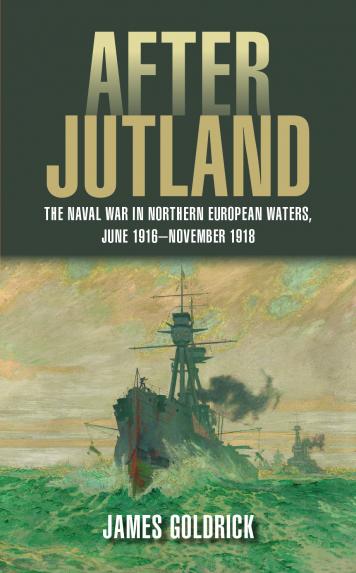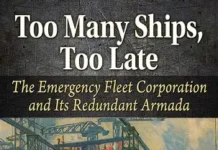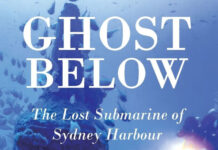
After Jutland: The Naval War in Northern European Waters June 1916 – November 1918. By James Goldrick. Seaforth, Barnsley, 2018.
Reviewed by Gregory P. Gilbert
AFTER JUTLAND is a well-researched and comprehensive history of the war at sea during the second half of World War I. After several years of commemorative military history publications dealing with the First World War it is fair to say that very few new releases have generated original thinking about that cataclysmic conflict. James Goldrick’s recent work ‘After Jutland’ breaks the well-worn mould.
As the subtitle suggests it offers a fresh look at the naval war in northern European waters from June 1916 until the end of the war in November 1918. Essentially although ‘After Jutland’ sets out a chronological discussion of the most important naval operations in the latter half of the Great War, it is very much more. It sets out the major developments in technology, personnel and command that have defined naval operations ever since.
James Goldrick sets out to answer two important questions. Whether the navies achieved all they could between 1916 and 1918, and if the navies did not succeed, why not? He provides answers to these in a thorough, thought-provoking and easy to read manner. He does not shy away from some reassessments and judgements but his views are well supported by his deep historical knowledge of the period and his own extensive experience of modern naval operations.
For many uninitiated the myth of decisive naval battle, such as Trafalgar, remains a central feature of naval strategy. For them the Battle of Jutland in 1916 was the only major event at sea during WWI. This was clearly not the case. As ‘After Jutland’ describes there were many smaller actions fought in northern waters from 1916 on. A more enlightened understanding of modern naval strategy shows that, rather than one or two battles, it is the ongoing ability of ships, submarines and aircraft to conduct operations at sea that really matters. The British with the help of the Commonwealth and the Allies maintained the blockade of Germany well into 1919. The blockade had a disastrous impact upon Germany’s ability to feed its population and keep its industries in production and in turn effectively stalled the German military’s ability to wage war. This blockade was underpinned largely by the Grand Fleet and the Royal Naval flotillas in the Channel. There were no more fleet actions such as Jutland but many smaller actions were fought in the North Sea to keep the pressure on Germany.
By November 1918 the naval war had evolved to such a point that it effectively characterised much of what we now understand as modern naval operations. The idea of concentrated fleets attacking their opponent’s fleet with gunnery, with big ship against big ship, was mostly a thing of the past. During WWI every navy learnt how to fight by actually fighting and the way they fought each other evolved very rapidly year by year. By 1918 however battle fleets had become unmanageable and battle squadrons were the new norm. That said, modern battleships could not operate alone, rather they were part of an integrated combat system of ships, submarines and aircraft. Large battleships not only needed protection from smaller torpedo armed ships but from submarines and mines, as well as from bomb or torpedo carrying aircraft. The importance of mine warfare during 1917-18 is underappreciated even today when the modern equivalents are likely to have an equally prodigious effect upon naval operations. Overall in modern parlance, by 1918, naval warfare was three dimensional with surface, subsurface and air elements. This does not imply that naval warfare has not evolved significantly since those times, instead it needs to be recognised that many of the experiments and combat experiences from 1916-18 remain relevant today.
‘After Jutland’ also demonstrates that rapid advances in naval technology and the subsequent operational practices and procedures were not the most important factor in the Allied naval victory. The success of countless naval operations was due to the effective management of naval personnel. The Royal Navy had significant personnel challenges during the latter part of WWI, including discipline, rates of pay, training, promotion and experience. However the RN managed their way through these difficulties and was able to maintain a force of men that was able to fight, learn, adapt and lead their way to victory. There were some areas, such as the intellectual capabilities of some senior leaders, which required generational improvements and could not be corrected in just a few years. The Royal Australian Navy inherited many of these problems of personnel management from the RN, although in most cases Australian manned ships operated in teams like the happier crews of RN ships. The important thing is that the Royal Navy avoided the collapse of its naval personnel system as happened to the Imperial Russian Navy in late 1917 and then the Imperial German Navy in late 1918. These examples saw sailors mutiny against their officers because of major inequalities within their respective navies, bad personnel policies and disillusionment within their families and communities. The mutinies led part to significant political unrest and ultimately economic and social collapse in both countries. It should be a clear warning to those who might pay lip-service to the personnel needs of modern navies. Sailors never should be treated the same as soldiers or airmen who do not live on a ship, are not isolated from their families and who have long-term dedicated skills and experience. Sailors live in such a way that is totally alien to many others in society.
Overall ‘After Jutland’ is a much needed addition to the commonly available naval histories of WWI but it is more it is a beacon for those who wish to think about the past in order to better understand the future. Highly recommended.



